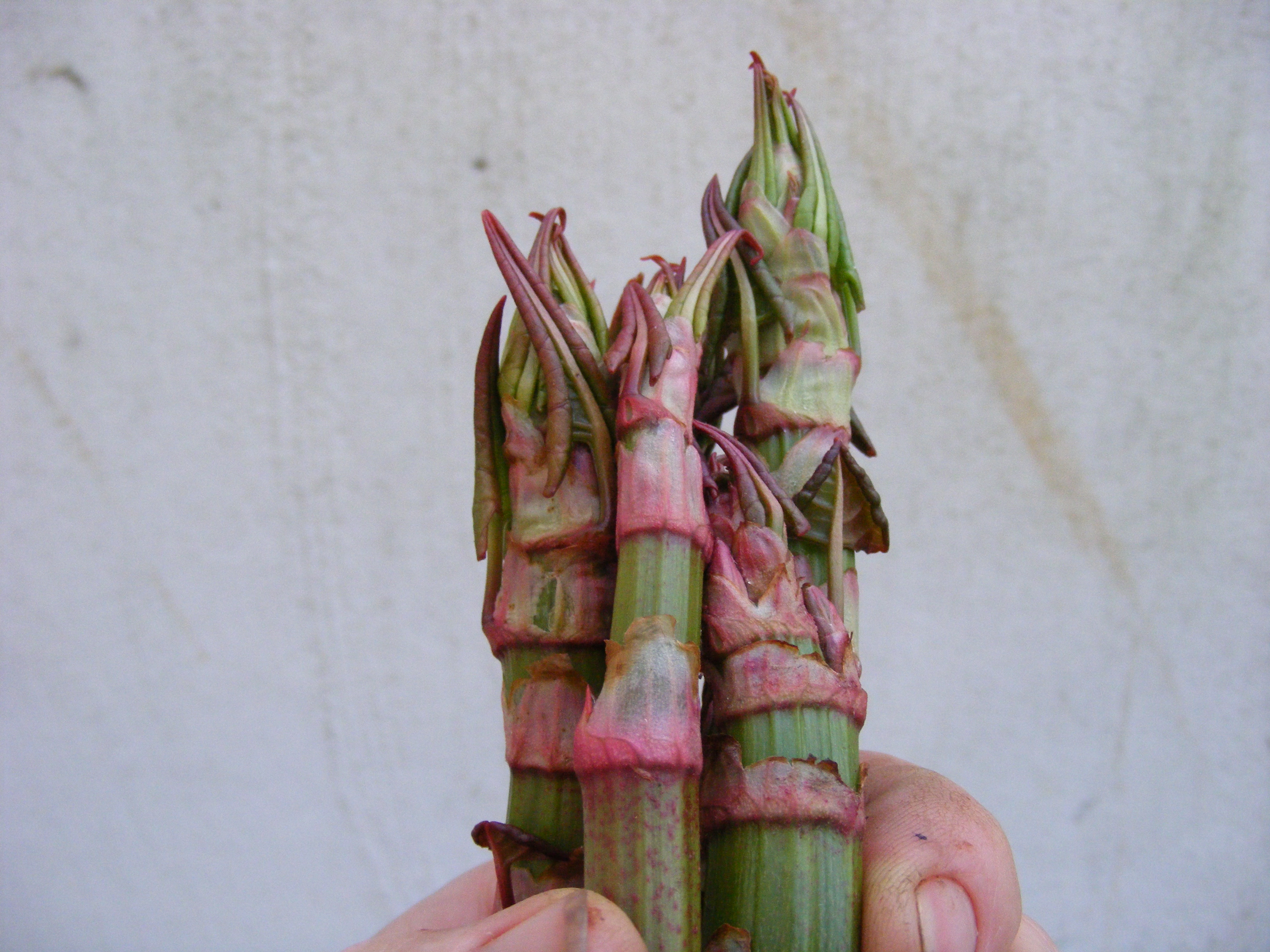
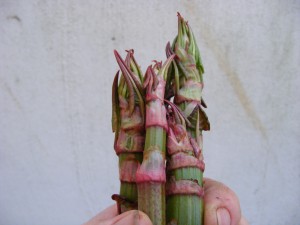 Eating and drinking Japanese Knotweed
Eating and drinking Japanese Knotweed
Japanese Knotweed was first introduced to our shores as a garden plant in about 1825. It doesn’t form any viable seed in this country so it’s rather remarkable how much it has spread. It is said that there is some growing in every 10km grid square in the UK, a sobering statistic.
Just like stinging nettles it spreads by the root (rhizomes) and a piece the size of a postage stamp is all that is needed to grow a new plant. This means it can often be spread by vehicles with tracks (diggers etc) or by unscrupulous contractors dumping knotweed contaminated soil. It can also be seen alongside river banks. Small pieces of the root structure often fall in the water and are swept downstream and washed up in their new surroundings ready to wreak havoc.
I am in awe of this plant and what it can do as it sounds like something from a comic book. It can grow up to 20cm a day, it grows through concrete and tarmac, the roots can spread down 3 meters (9 feet) and over a 7 meters (21 feet) radius and it can withstand temperatures of below minus 35°c. It is of little wonder that this plant is so hardy when its native habitat is on the side of a volcano!
These facts mark Japanese Knotweed as the number 1 invasive plant species across our planet. It has been estimated that getting rid of Japanese Knotweed in the UK will cost £13.5 billion and getting rid of it just at the Olympic site is thought to have cost around £70 million.
Yet most of us foragers are shouting at the top of voices, “WHY DON’T YOU EAT IT”! It might seem odd but knotweed is a great food and tastes very much like rhubarb. Indeed, fellow forager and friend Fergus Drennan, the man who first introduced me to the culinary delights of knotweed, has conducted an experiment. He gave a group of people in a pub some knotweed crumble and another group some rhubarb crumble. They were unable to tell the difference.
Foraging for Japanese Knotweed
Often when mentioning wild food there are very specific conditions in which each plant grows, but knotweed, grows where it likes. I have seen it growing out of graves, through concreated front gardens and on shore line of the Firth of Forth on the outskirts of Edinburgh; it can also grow inside peoples homes up through the floor boards. But it is mostly found by railway lines, river banks, in unmanaged woodland and on wasteland. I often see it growning where earth from an infected site has been dumped.
There are a few tips to follow when foraging for knotweed. Firstly, make sure you know the area and more to the point make sure it has not been sprayed. Only harvest when it is young, which in the UK is around March-May depending on the weather and where you are in the country. The ideal size of your knotweed shoots is between 20-25cm (6 to 8 inches). If there is none around at this size then just the top 20cm can be harvested. Older plants and longer stems can be harvested too but they may have to be peeled if a little tough. Leaves should be burnt.
When preparing knotweed make sure you burn any leftover scraps as the plant has been known to reproduce for a piece the size of postage stamp hitting the floor. You can face a fine or imprisonment under the Countryside act of 1981 if you knowingly spread Knotweed so PLEASE be careful with it. I will repeat, burn any leftovers!
To correctly identify knotweed and other wild food plants please join me on one of my foraging tuition walks. I’ve also mentioned a little bit more in this months Home Farmer Magazine.
Eating knotweed to get rid of it
As the plant is weakened every time you cut it, it is possible at the least keep it in check by continual harvesting; and at best eradicate it. To ensure a greater chance of eradication you do have to dig out all the root and burn it on site too. Then continually harvest the new shoots all year.
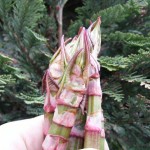 I have spoken to someone who has knotweed growing in their garden and over 5 years they managed to eradicate it buy continual cutting. If she’d have known she would have eaten it too!
I have spoken to someone who has knotweed growing in their garden and over 5 years they managed to eradicate it buy continual cutting. If she’d have known she would have eaten it too!
To see how to cook it look below, it is certainly worth giving it a go as Knotweed is full of vitamin A and vitamin C it also contains potassium, zinc, phosphorous, manganese. Those with gout or kidney stones should be slightly wary as it does contain oxalic acid which is known to aggravate both conditions.
Drinking Japanese Knotweed
There are recipes for Knotweed wine and knotweed ale in my book, Booze for free which is out this Autumn. But you can also make knotweed tea. It is made by simmering the knotweed for 20 mins and adding sugar to taste and serving chilled. This is great as it means the leftover water from stewing knotweed can be drunk. The Japanese drink knotweed tea and over there it is known as Itadori tea. It is high in resveratol it can really help against bad cholesterol.
Cooking Japanese Knotweed
Follow any recipe that has been made using rhubarb. My personal favourite recipe is also one of the simplest –
Knotweed crumble
- 30 lengths of knotweed
- 1 banana
- 4 tablespoons orange juice
- 1 tsp powdered ginger
- 120g Butter
- 120g soft brown sugar
- 180g flour
Method
Cut knotweed into 5 cm chunks place in an oven proof dish and pour over orange juice and add up mashed banana into the gaps. Mix the other ingredients with your fingers and sprinkle over the top. Place in pre heated oven at 180°c and cook for 20 mins or until the crumble has turned golden.
Knotweed fool
Ingredients
2 tablespoon of sugar or half a litre of apple juice
- A big handful of knot weed (12 shoots)
- 2 Bananas
- 1 cup of double cream
Method
Cook the knotweed for a few minutes in sugared water (or apple juice) until tender. Strain and blend until proper mash up. Throw in the bananas and blend them too. In the meantime beat the cream until it is stiff. Fold in the resulting goo. Refrigerate for about an hour and serve with a foolish countenance.

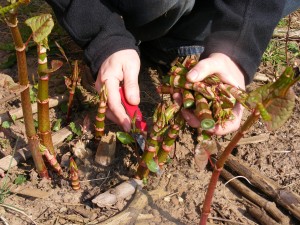

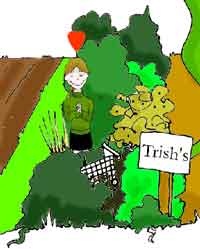
Hmm…knotweed wine.
Do we really have to wait for the new book coming this autumn?
(Can we have just one spoiler? 😀 )
You are a laugh!
What’ she like?
As long as you still buy my book!
Ever made rhubarb wine? Replace Rhubarb with knotweed.
Gosh, what an inexpensive substitute for rhubarb, Japanese knotweed would be; is that true about using knotweed instead?
Ah,sim-ple 🙂
Thanks,and Yes,I will buy the book.
Home-brewing is what got me here in the first place.;)
Just one question,should I use young shoots or full-grown stems?
Well you can use slightly older stems as you are just getting the essence out of it, but I’d stick to new shoots just because they give a better flavour. Harvest from now (ish) and put in the freezer to break them down a bit.
Thanks again,now let’s eradicate some knotweed next weekend. 😀
Don’t like the idea of having it inside me. Suppose it starts growing?! 🙂
Reminds me of a horror story I read once.
Hello!
Eating Japanese Knotweed sounds like a great idea. One small thing – your crumble recipe contains 120g sugar and 120g soft brown sugar. Perhaps the first ‘sugar’ should be ‘butter or vegetable margarine’.
Thanks
This all sounds great – To be honest, I’ve never heard of Knotweed. What kind of terrain does it typically grow in?
@gail – just make sure you cook it first or it will and it will start to grow from your nose!
@ K well spotted, cheers (I’ve changed it)
@ Mike Another good point, I’ve added a bit to the foraging section. It’s difficult to be consise when writing about knotweed so much so I missed out the obvious!
i really like the idea of getting rid of it by eating it away 🙂 I’d be scared to bring any home though..
As a child in the late 1950’s and early 60’s I used to collect what we called ‘Wild Rhubarb’ from the waste ground around Charlton Athletic Football Club in London. Does that give me some sort of intellectual property rights? Royalties? Please send cheques to…
Hi
I have knot weed at the bottom of the garden For three years now I have been pulling it up and some times eating it.it is also nice as tempura,and stir fried.How ever I have read that when cows graize on it they become sensitive to the sun and there skin starts to peel. I assume that over consumption may have the same result in a human.So perhaps that which can heal can inflict and perhaps moderation should be counciled.
Does an body have knowledge of any possible side effects?
Another thing that is good as tempura is Police mans Helmet .Does any body know of any side effects to eating this also?
@ red, ah don’t worry as long as you eat it!
@ Chris It would do, but I’m afraid as you support Charlton I can’t bring myself to send any.
@Hello John, I’d been interested in reading a source about that, if you still have one?
I know that it is sold commercially in some countries and without warnings and I’ve not found any other references of the toxicology of Knotweed in my posion books. As it gets older it should be left alone and of course if it’s been sprayed it should be left. Also, just as with sorrel and rhubarb, anyone who is sensitive to oxalic acid should leave well alone, so noone with kidney stones or gout should eat it.
Just to warn you guys, Japanesse Knotweed can cause serious skin reactions in some people. I am a gardener, recently I cut and disposed of a small amount of knotweed. The next day I came up in terrible blisters all over my skin that had been exposed to the Knotweed. These continued to erupt and burst over a number of days. They lasted for a few weeks at least and left horrible scars, which are now fading, at last! They looked gross. After much research I finally found the cause, the sap and hairs form these plants, once on your skin can cause a photo sensitive reaction – I had been out in full sunlight for hours after. So this brought the blisters on lovely! Once the blisters burst the fluid inside can also cause the same photo sensitive reaction. This can cause further problems for years after in when the skin is exposed to UV rays. I’m guessing this must only be in certain people as some people can handle it and not be affected at all.
Many people are aware of the dangers of handling giant hogweed – the severe skin reaction this can cause is identical to that I received from Knotweed. It just doesn’t seem as common to have this reaction.
So don’t want to scare you all away from eating it, but suggest you do a little skin test on yourself first.
Hello Cathtryn,
Thanks for sharing your experience.
I`ve been handling knotweed for many years as part of my project: “Bionic control of invasive plant species” and before I read your comment I`ve only heard about this reaction once, about ten years ago from:_ Wildfood Adventures`John Callas. It must be a rare allergy, because to most people the knotweed juice feels more like an ointment to treat skin rashes, insect bites and it also helps against nettle burns.
Especially because I`m producing knotweed soap I would like to learn all about your skin reaction. Are you allergic to other members of the Polygonaceae family; like buckwheat or sorel ? I hope your skin reaction is healing at last. Both Calendula and Aloe vera is supposed to help healing such skin irritations.
Greetings from the Knottyfood Manufactory
Peter Becker
Hello Cathryn, thanks for the post – Was this the new shoots (about the size of asparagus) or older plants. It is true that this reaction can occur, its similar to hogweed, but I thought it was only in older stems?
i like the idea of eating it. i am also on a quest to find out if raising the pH of the soil will deter the future growth of the plants.. i know that lots of plants are indicator species for certain soil types and conditions. any ideas? louis b.
Japanese knotweed loves all ph soil types, and, therefore, there is no easier or quicker way of eradication…. you have got a five year wait.
Thank you for replying to my post Peter and Dave.
I am not allergic to any other plants in the Polygonaceae family. I am not actually allergic to anything for that matter, and have never suffered with any skin sensitivity or rashes.
I had removed both older and new shoots, so i’m not sure if the new shoots played a part.
I have since writing my last post developed the same reaction although not so severe. Every where I had blisters last year, I now have red sore blotches but only a couple of blisters have so far appeared.
This is not from handling knotweed again,I stay well clear now. It is a reacurring photosensitive reaction. I read that this can happen each time your skin is exposed to Uv light, which it has been. It has its own name when this reaction is caused by plants phytophotodermatitis. I’m wondering how common this is to have this reaction, as its difficult to pin point what has caused it. The blisters don’t appear until at least 24-48 hours after, so I reckon most people wouldn’t think it could be from something they touched 2 days before.
Thank you for your advice Peter – I shall be using Aloe vera and Calendula and hope this helps with scaring too, as they look horrible. Today I have over 100 blotches, a couple of them blisters on one arm and about half that amount on the other arm. I have more today than I did yesterday. So there still coming up for now. I’m hoping these blotches don’t blister as they did last year when I actually handled the Knotweed.
Well guys your receipe’s and soap sound lovely, but I think I might have to give them both a miss.
Thank you for your replies.
I was told that knotweed was edible only hours ago. I will be harvesting some of the problem around my rrelatively new allotment soon. I’ll try the knotweed crumble…
We have another pest though: rabbits. Any suggestions for a knotweed/rabbit recipe?
half a rabbit, diced,
10 lengths or more if desired knotweed,
A pound of potatoes cut up,
A few sticks of diced celery,
Vegetarian or meat flavoured stock cubes,
Salt and pepper. Cumin seed for flavour also.
Simmer all ingredients in enough water to cover and towards the end replace some water with the stock cubes. I have tried the casserole and it is very nice.
So, basically, to cook, all I do regarding knotweed is to obtain a few newish one foot long stems, avoiding leaves and the harder parts, peel if necessary and cook with, say a few bananas and sugar, that is all? AND then, EAT?
Wow! fantastic……. I just had Rhubarb crumble last week, my garden, the bit I don’t use, is absoloutly infested with it. what a great piece of news, anyone want to buy some Knot weed?
If this gets out, its going to be an endangered spicies, lets all eat our way to conquering this nightmare plant. I think I’ll still grow the traditional plant though.
Hi there, I have just come down with the exact same skin condition. I hope it works out better than Cathryns/ I dealt with knotweed prior to this and didn’t have a reaction but now both arms are covered in the blotches. Extremely itchy. I am using Benadryl so hopefully that will help, The doctor also prescribed a topical ointment-steroid.
There are a number of plants that cause photosensitivity, among them celery, carrots, lime,parsley, bergamot oil, psoralen, etc. I have experienced a very bad burn after using bergamot oil on my skin and being in the sun too long also. I would recommend for anybody harvesting or working around Japanese Knotweed either to cover their arms and hands and/or not go into the sun for two days afterwards.
Any benefits from the roots, or only the stalk?
The roots have are widely used in herbalism, they have high levels of resveratrol a antioxidant. It is the shoots rather than the stalk you want.
We used to eat “wild rhubarb” i.e. Knotweed when we were kids, the tops were juicy and refreshing but slightly lower you had to peel it. We used to also cut the stems just below the joint above and there was normally a small drink in the stem sections.
We never had it cooked, always raw and when I look back, quite a bit of it!.